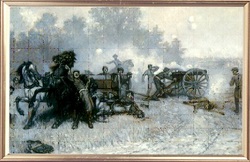Field Guns

Model 1841 12-pdr Gun
Packing a solid punch and having a respectable 1600-1700 yard effective range, the 12-pdr was a much better weapon than its little brother. But its weight (1800 lbs) was a liability, just about at the top limit for the requirements of mobility in the field.
Model 1841 12-pdr Howitzer
This was by far the most effective field piece of the war for use at any range under 400 yards. Its large shells gave it firepower, while its light weight (less than 800 lbs) made it highly mobile and easy to position, even by hand.
Because of its mobility, the piece was readily adaptable for close infantry support. Nine of them were supposed to have followed the infantry in Pickett's Charge so as to protect its flanks and render whatever service they could in front. However some confusion of orders and effective Federal artillery fire during the pre-charge cannonade resulted in the nine pieces being unavailable. It is interesting to speculate what difference they might have made had they accompanied Pickett's troops. The 12-pdr howitzer's great weakness was its effective range, which is not much over 1,000 yards, well under that of even the 6-pdr gun. It made the piece an easy target for other artillery.
Model 1841 24-pdr Howitzer
When positioned in field fortifications, these were extremely useful pieces of ordnance because of their powerful 5.82 inch shells. Their 1400 pound weight made them a bit unwieldy in the field, and their 1300-1400 yard effective range put them at a disadvantage to other pieces. Nevertheless, infantrymen could not have relished the idea of charging a battery of 24-pdr howitzers.
E. Porter Alexander, General Longstreet's de facto Chief of Artillery for much of the war, called them "my favorite guns." (Alexander, p. 182) On occasion, he even had them mounted on skids and used as mortars.
Packing a solid punch and having a respectable 1600-1700 yard effective range, the 12-pdr was a much better weapon than its little brother. But its weight (1800 lbs) was a liability, just about at the top limit for the requirements of mobility in the field.
Model 1841 12-pdr Howitzer
This was by far the most effective field piece of the war for use at any range under 400 yards. Its large shells gave it firepower, while its light weight (less than 800 lbs) made it highly mobile and easy to position, even by hand.
Because of its mobility, the piece was readily adaptable for close infantry support. Nine of them were supposed to have followed the infantry in Pickett's Charge so as to protect its flanks and render whatever service they could in front. However some confusion of orders and effective Federal artillery fire during the pre-charge cannonade resulted in the nine pieces being unavailable. It is interesting to speculate what difference they might have made had they accompanied Pickett's troops. The 12-pdr howitzer's great weakness was its effective range, which is not much over 1,000 yards, well under that of even the 6-pdr gun. It made the piece an easy target for other artillery.
Model 1841 24-pdr Howitzer
When positioned in field fortifications, these were extremely useful pieces of ordnance because of their powerful 5.82 inch shells. Their 1400 pound weight made them a bit unwieldy in the field, and their 1300-1400 yard effective range put them at a disadvantage to other pieces. Nevertheless, infantrymen could not have relished the idea of charging a battery of 24-pdr howitzers.
E. Porter Alexander, General Longstreet's de facto Chief of Artillery for much of the war, called them "my favorite guns." (Alexander, p. 182) On occasion, he even had them mounted on skids and used as mortars.